Understanding and Resolving Litter Box Challenges in Feline Companions
2024-03-29
As responsible pet owners, ensuring our cats have proper bathroom habits is crucial for their health and our household's cleanliness. However, there are times when our feline friends may exhibit behaviors indicating they're not using the litter box correctly. Recognizing these signs early and addressing them promptly is essential to prevent potential health issues and maintain a harmonious living environment. Here are some common signs that indicate a cat may not be using the litter box properly and strategies to address this issue:
1. Urinating or Defecating Outside the Cat Litter Box: One of the most obvious signs of litter box problems is finding urine or feces outside the designated area. This behavior may indicate dissatisfaction with the litter box or underlying health issues.
Solution:
- Ensure the litter box is clean and properly maintained. Scoop it daily and perform a deep clean regularly.
- Provide multiple litter boxes in different locations, especially in multi-cat households.
- Experiment with different types of litter to find the one your cat prefers.
- Rule out medical issues by consulting with your veterinarian if the behavior persists.
2. Spraying: Cats may spray urine outside the litter box as a form of territorial marking or to express anxiety or stress. This behavior can be particularly challenging to deal with but is often a sign of underlying issues.
Solution:
- Identify and address potential stressors in the cat's environment, such as changes in routine, new pets, or unfamiliar scents.
- Use pheromone diffusers or sprays to help calm anxious cats.
- Neuter or spay your cat if they are not already altered, as this can reduce spraying behavior in many cases.
- Consult with a veterinary behaviorist for additional guidance and support.
3. Excessive Digging or Scratching: Cats may exhibit excessive digging or scratching behavior in or around the litter box, which can indicate discomfort or dissatisfaction with the litter substrate.
Solution:
- Ensure the litter box is adequately sized and filled with an appropriate depth of litter.
- Experiment with different types of litter to find one that your cat finds comfortable.
- Consider providing a variety of litter box options, including covered and uncovered boxes, to accommodate your cat's preferences.
4. Avoidance Behavior: Some cats may actively avoid using the litter box altogether, preferring to eliminate in other areas of the home. This behavior can be frustrating for owners and may indicate underlying issues that need to be addressed.
Solution:
- Rule out medical issues by consulting with your veterinarian to ensure there are no underlying health problems.
- Clean soiled areas thoroughly with enzymatic cleaners to remove odors and discourage repeat incidents.
- Provide positive reinforcement and rewards when your cat uses the litter box correctly.
- Seek guidance from a veterinary behaviorist for more complex cases.
5. Changes in Litter Box Habits: Any sudden changes in your cat's litter box habits, such as increased frequency of use or reluctance to enter the litter box, should be taken seriously and investigated promptly.
Solution:
- Monitor your cat's behavior closely and document any changes or patterns.
- Rule out medical issues with a thorough veterinary examination.
- Address any environmental stressors or changes that may be contributing to the behavior.
In conclusion, recognizing and addressing litter box issues in cats requires patience, observation, and proactive intervention. By identifying potential problems early and taking appropriate steps to address them, you can help ensure your cat maintains proper litter box habits and enjoys a happy, healthy life. Remember to consult with your veterinarian or a qualified animal behaviorist if you need assistance in resolving litter box issues effectively.


